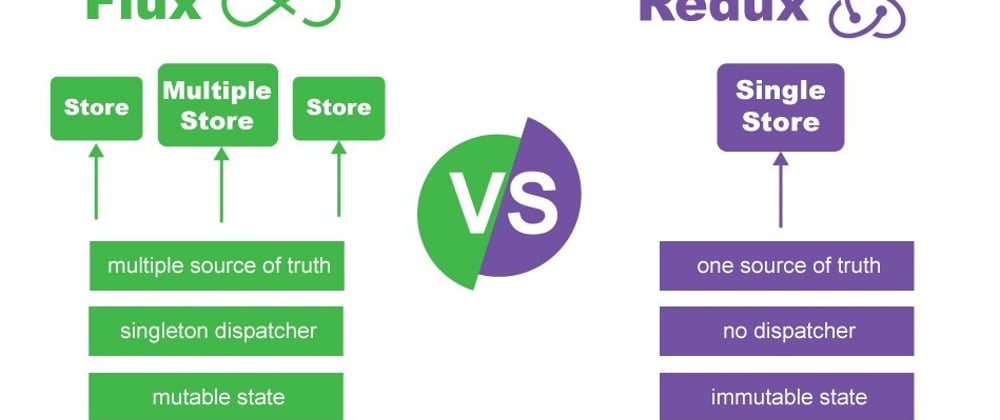In this post, we’ll try to compare — Flux and Redux. Both technologies allow you to manage state in your app. Both are a great tool because they allow developers to quickly store and manage state in his app.
Redux is a standalone state management library, which can be used with any library or framework. If your background is React developer, then you have used the Redux library with React. The primary use of Redux is that we can use one application state as a global state and interact with the state from any react component is very easy whether they are siblings or parent-child.

Basic usage of Redux comes into picture when the app gets large and complex. In such apps, simple data management as parent-child becomes difficult using props. There are multiple components trying to communicate with multiple other components. In such cases, Redux comes in handy.
Redux can be broken down into few sections while building the application which is listed below.
Actions: “are payloads of information that send data from your application to your store. They are the only source of information for the store.” this means if any state change necessary the change required will be dispatched through the actions.
Reducers: “Actions describe the fact that something happened, but don’t specify how the application’s state changes in response. This is the job of reducers.” when an action is dispatched for state change its the reducers duty to make the necessary changes to the state and return the new state of the application.
Store: with help of reducers a store can be created which holds the entire state of the application it is recommended to use a single store for the entire application than having multiple stores which will violate the use of redux which only has a single store.
Components (UI): This is where the UI of the application is kept.
Middlewares: middleware can be used for a variety of things, including asynchronous API calls. Middleware sounds much more complicated than it really is. The only way to really understand middleware is to see how the existing middleware works and try to write your own.we will cover middleware in the next blog.

What is the Flux?
Flux is a Javascript architecture or pattern for UI which runs on unidirectional data flow and has a centralized dispatcher. It is useful when your project has dynamic data and you need to keep the data updated in an effective manner. It was created by Facebook and complements React as view. This model is used to ease maintenance. It has three primary components: Views, Stores, and Dispatcher. As the MVC application grows, we find many numbers of views as models, which are all talking to each other, making it difficult to manage and debug.

Flux is more of a pattern than a framework and does not have any hard dependencies. However, we often use EventEmitter as a basis for Stores and React for our Views. The one-piece of Flux not readily available elsewhere is the Dispatcher. This module, along with some other utilities, is available here to complete your Flux toolbox.
Flux can be broken down into few sections while building the application which is listed below.
Actions: “are payloads of information that send data from your application to your store. They are the only source of information for the store.” this means if any state change necessary the change required will be dispatched through the actions.
dispatcher: The dispatcher is a singleton, and operates as the central hub of data flow in a Flux application. It is essentially a registry of callbacks, and can invoke these callbacks in order. Each store registers a callback with the dispatcher. When new data comes into the dispatcher, it then uses these callbacks to propagate that data to all of the stores. The process of invoking the callbacks is initiated through the dispatch() method, which takes a data payload object as its sole argument.
Store: In Flux, Stores are simply a place where data is read out from. More specifically, Views within a Flux architecture will be notified of changes within Stores via the Observer pattern, and then query for those data in order to update their own states.
View : This is where the UI of the application is kept.

const someAction = {
type: "Test",
payload: {user: "Test User", age: 25},
}This is a generally accepted convention to have a type and a payload for an action. The payload can be any valid JS type (array, object, etc ).
Top 10 Attributes to Consider While Selecting the State Management tool for any website.
To decide which one is better for State Management, lets first define the attributes based on which we will compare all of the above. And, these are:
- Developed By
- Stable Release
- Initial Release
- Github Stats
- Store
- Dispatcher
- State
- Workflow
- Final Words (Pros and cons)
Developed By:-
Redux was created by Dan Abramov and Andrew Clark. Abramov began writing the first Redux implementation while preparing for a conference talk at React Europe on hot reloading.
Flux was created by Facebook For forcing an unidirectional flow of data between a system’s components.
Initial Release:-
Redux:- 2, June 2015
Flux:- June 2011
Stable Release:-
Redux:- 4.0.0 in April 2017
The major changes in the stable release are around our TypeScript definitions, bundled CommonJS and ES builds, throwing if you subscribe or getState from a reducer, and a bunch of other smaller things. The full changes are listed below.
Flux:- 3.1.3 on Nov 2016
The major changes in the stable release are added support for React 16
Github Stats:-
Flux:-
Github Stars:- 16331
Contributors:- 114
Total commits:- 394
Total open issues:-10
Total Closed Issues:-216
React:-
Github Stars:- 50499
Contributors:- 698
Total commits:- 2094
Total open issues:-27
Total Closed Issues:-1648
Store:-
With Flux it is a convention to have multiple stores per application; each store is a singleton object. In Redux, the convention is to have a single store per application, usually separated into data domains internally (you can create more than one Redux store if needed for more complex scenarios).
Flux:- Multiple Store
Redux:- Single Store
Dispatcher:-
Flux has a single dispatcher and all actions have to pass through that dispatcher. It’s a singleton object. A Flux application cannot have multiple dispatchers. This is needed because a Flux application can have multiple stores and the dependencies between those stores need a single manager, which is the dispatcher.
Redux has no dispatcher entity. Instead, the store has the dispatching process baked in. A Redux store exposes a few simple API functions, one of them is to dispatch actions.
State:-
The other bigger constraint is that the store’s state in Redux cannot be mutable (or really, shouldn’t be). There is no such constraint in Flux, you can mutate the state as you wish. The state’s immutability, in Redux, is achieved easily by making the reducers pure functions (with no side effects). Redux reducers always copy the state they receive and returns a modified version of the state’s copy, not the original object itself. While this is a big constraint, it makes life much easier long term.
Redux:- Immutable
Flux:- Mutable
Workflow:-
Having a similar state, action and unidirectional data flow, the Flux and Redux do have some workflow differences. Let’s understand the two technologies one-by-one.
How Flux Functions
Flux, in simple term, allows unidirectional data flow which is an essential part of keeping things predictable. You can understand this; you need to know how MVC architecture functions. The MVC architecture includes;
Action → Controller → Models →Views
In which Models and Views do not follow the bidirectional data flow which becomes extremely tough when complexity gets higher. There will be no clue to find exactly where the changes occur and that in result give rise to bugs.

While unidirectional data flow abided by Flux empowers applications to avoid the shimmering effect, and the process takes place something like the diagram below;

You may have got the precise idea of how Flux works.
How Redux Functions
As Redux is predictable state container for JavaScript apps, it has actions like Flux but here it’s a simple JavaScript object while using Redux, action will turn into functions and promises. It’s a small library and has been designed with a concept to be a predictable container for application state. Flux can be implemented along with a number of frameworks while Redux works to simplify and streamline the concept of (most of) Flux.
Redux is built on the concept of;
Actions → Store → Reducers → Subscriptions

As you can see in some cases, Flux matches the Redux. The two technologies are also similar in terms of unidirectional data flow and aligning state implying ‘type’ field.

Final Words:-
Flux and Redux are a very integral part of the development and it is equally important for developers to know their usages. They are a small but powerful tool which makes your applications’ user interface attractive and usable.
Some pros and cons of Redux and Flux
Redux
- Predictable State
- Work well with react
- Easy Debugging
- Log Everything
- Test without browser
- Hot reloading
- State stored in a single object
Flux
- Unidirectional Data flow
- No MVCopen Source
Next Steps
Now that you have learnt the major differences between Redux and flux for state management in your app, you can also try
- React Native life cycle hooks
- How To integrate in React Native — Image picker| Integrate Firebase
- Create Awesome Apps in React Native using Full App
- Firebase Push notifications in React Native Apps
If you need a base to start your next React Native app, you can make your next awesome app using React Native Full App








Top comments (0)